Complete Solutions to EXAMPLE of chapter PROBABILITY of Class 9 book with complete answers and questions
| Class 9 | MATHS |
| Chapter | PROBABILITY |
| MODERN PUBLICATION | EXAMPLE |
| Number Of Questions | 53 |
| Academic Year | 2023-24 |
In a cricket match, a batsman hits a boundary 10 times out of 50 balls he plays. Find the probability that the does not hit a boundary.
View SolutionA coin is tossed 500 times with the following frequencies: Head : 255, Tail: 245. Compute the probability for each event.
View SolutionTwo coins are tossed simultaneously 500 times, and we get:
Two heads: 115 times, One head: 165 times, No head: 120 times, Find the probability of occurrence of each of these events.
View SolutionThree coins are tossed simultaneously 150 times and it is found that 3 heads appear 25 times, 2 heast appear 40 times, 1 head appears 75 times and no head appears 10 times. If three coins are tossed simultaneously at random, find the probability of getting:
3 heads.
View SolutionThree coins are tossed simultaneously 150 times and it is found that 3 heads appear 25 times, 2 heast appear 40 times, 1 head appears 75 times and no head appears 10 times. If three coins are tossed simultaneously at random, find the probability of getting:
2 heads.
View SolutionThree coins are tossed simultaneously 150 times and it is found that 3 heads appear 25 times, 2 heast appear 40 times, 1 head appears 75 times and no head appears 10 times. If three coins are tossed simultaneously at random, find the probability of getting:
1 head
View SolutionThree coins are tossed simultaneously 150 times and it is found that 3 heads appear 25 times, 2 heast appear 40 times, 1 head appears 75 times and no head appears 10 times. If three coins are tossed simultaneously at random, find the probability of getting:
0 head
View Solution1500 families with 2 children each, were selected randomly and the following data were recorede:
 Out of these families, one family in selected at random. What is the probability that the selected family has:
Out of these families, one family in selected at random. What is the probability that the selected family has:
no girl.
View Solution1500 families with 2 children each, were selected randomly and the following data were recorede:
 Out of these families, one family in selected at random. What is the probability that the selected family has:
Out of these families, one family in selected at random. What is the probability that the selected family has:
1 girl
View Solution1500 families with 2 children each, were selected randomly and the following data were recorede:
 Out of these families, one family in selected at random. What is the probability that the selected family has:
Out of these families, one family in selected at random. What is the probability that the selected family has:
3 girls?
View SolutionMarks obtained by 2500 students are shown in the following table:
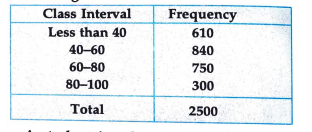 A student is selected at random. Find the probability that : he scores more than 80% marks.
A student is selected at random. Find the probability that : he scores more than 80% marks.
View SolutionMarks obtained by 2500 students are shown in the following table:
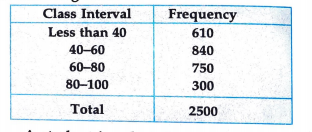 A student is selected at random. Find the probability that : he scores less than 60% marks.
A student is selected at random. Find the probability that : he scores less than 60% marks.
View SolutionFour coins are tossed simultanesouly 150 times with the following frequencies of difference outcomes:
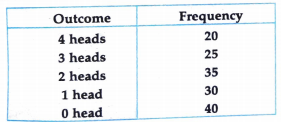 Find the probability of more than 2 heads
Find the probability of more than 2 heads
View SolutionFour coins are tossed simultanesouly 150 times with the following frequencies of difference outcomes:
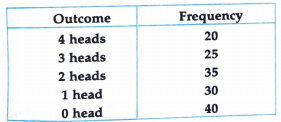 Find the probability of less than 2 heads.
Find the probability of less than 2 heads.
View SolutionThe record of a weather station shows that out of the past 250 consecutive days, its weather forecasts were correct 175 times. (i) What is the probability that on a given day it was correct? (ii) What is the probability that it was not correct on a given day?
View SolutionAccording to a meteorological report for 300 consecutive days in a year , its weather forecasts were correct 180 times .
Out of these days , one day is chosen at random .
What is the probability that the weather forecast was
not correct on that day ?
View SolutionIn a cricket match, a batsman hits a boundary 10 times out of 50 balls he plays. Find the probability that the does not hit a boundary.
View SolutionA coin is tossed 1000 times with the following frequencies: Head : 455, Tail : 545 Compute the probability for each event.
View SolutionTwo coins are tossed 400 times, we get: Two heads: 128 times, ON e head: 160 times, No head : 112 times when two coins are tossed at random, what is the probability of getting 2 heads.
View SolutionTwo coins are tossed 400 times, we get: Two heads: 128 times, ON e head: 160 times, No head : 112 times when two coins are tossed at random, what is the probability of getting 2 heads.
View SolutionTwo coins are tossed 400 times, we get: Two heads: 128 times, One head: 160 times, No head : 112 times when two coins are tossed at random, what is the probability of getting 0 head?
View SolutionA survey of 250 boys of a school was conducted and it was found that 110 like coffee and 140 do not like coeffee. Out these boys, one boy is selected at random. What is the probability that the selected boy:
likes coffee.
View SolutionA survey of 250 boys of a school was conducted and it was found that 110 like coffee and 140 do not like coeffee. Out these boys, one boy is selected at random. What is the probability that the selected boy:
does not like coffee?
View SolutionThe probability of guessing the correct answer to a certain question is `x/2`.If the probability of not guessing the correct answer is `2/3`. Find x
View SolutionAn integer is chosen form 1 to 100. Find the probability that:
integer chosen is a prime number.
View SolutionAn integer is chosen form 1 to 100. Find the probability that:
integer chosen is composite.
View SolutionAn integer is chosen form 1 to 100. Find the probability that:
a multiple of 11.
View SolutionThe following table gives life time of 400 neon lamps:
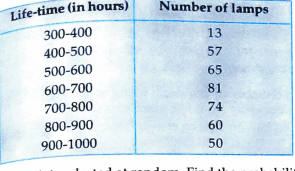 A bulb is selected at random. Find the probability of that the life time of the selected bulb is less than 500 hours.
A bulb is selected at random. Find the probability of that the life time of the selected bulb is less than 500 hours.
View SolutionThe following table gives life time of 400 neon lamps:
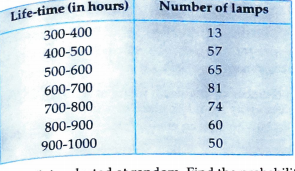 A bulb is selected at random. Find the probability of that the life time of the selected bulb is between 400 to 900 hours.
A bulb is selected at random. Find the probability of that the life time of the selected bulb is between 400 to 900 hours.
View SolutionThe following table gives life time of 400 neon lamps:
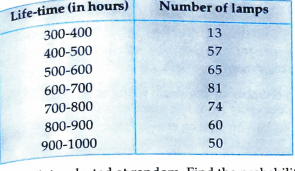 A bulb is selected at random. Find the probability of that the life time of the selected bulb is atleast 800 hours.
A bulb is selected at random. Find the probability of that the life time of the selected bulb is atleast 800 hours.
View SolutionTwo coins tossed simultaneously 300 times and its is found that two heads appeared 136 times, one head appeared 112 times and no head appeared 52 times. If two coins are tossed at random, what is the probability of geeting 2 heads.
View SolutionTwo coins tossed simultaneously 300 times and its is found that two heads appeared 136 times, one head appeared 112 times and no head appeared 52 times. If two coins are tossed at random, what is the probability of geeting 1 head.
View SolutionTwo coins tossed simultaneously 300 times and its is found that two heads appeared 136 times, one head appeared 112 times and no head appeared 52 times. If two coins are tossed at random, what is the probability of geeting 0 head?
View Solution12 packets of salt, each marked 2 kg, actually contained the following weights (in kg) of salt 1.950, 2.020, 2.060, 1.980, 2.030, 1.970, 2.040, 1.990, 1.985, 2.025, 2.000, 1.980 Out of these packets, one packet is chosen at random. What is the probability that the chosen packet contains more than 2 kg of salt?
View SolutionA man speaks truth 6 out of 9 times. What is the probability that he would not narrate an incident correctly.
View SolutionIn an experiment, a coin is tossed 500 times, If the head turns up 270 times. Find the experiment probability of getting a head.
View SolutionIn an experiment, a coin is tossed 500 times, If the head turns up 270 times. Find the experiment probability of getting a tail.
View SolutionIn a cricket match, a batswoman hits a boundary 6 times out of 30 balls she plays. Find the probability that she did not hit a boundary.
View SolutionRefer the data:
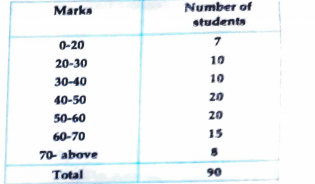 Find the probability that a student obtained less than 20% in the mathematics test.
Find the probability that a student obtained less than 20% in the mathematics test.
View SolutionRefer the data:
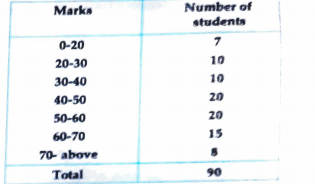 Find the probability that a student obtained marks 60 or above.
Find the probability that a student obtained marks 60 or above.
View SolutionActivity : Ask all the students in your class to write a 3-digit number. Choose any student from the room at random. What is the probability that the number written by her/him is divisible by 3? Remember that a number is divisible by 3, if the sum of its digits is divisible by 3.
View SolutionThe blood groups of 30 students of Class VIII are recorded as follows: A,B,O,O,AB,O,A,O,B,A,O,B,A,O,O, A,AB,O,A,A,O,O,AB,B,A,O,B,A,B,O. Use this table to determine the probability that a student of this class, selected at random, has blood group AB.
View SolutionCan the experiment probability of an event be a negative number? If not, why?
View SolutionCan the experimental probability of an event be greater than 1? Jusitfy your answer.
View SolutionAs the number of tosss of a coin increases, the ratio of the number of heads to the total number of tosses will be `1/2`. Is it correct? If not, write the correct one.
View SolutionTwo dice are thrown simultaneously 500 times. Each time the sum of two numbers appearing on their tops is noted and recorded as given in the following table:
 If the dice are thrown once more, what is the probability of getting a sum:
If the dice are thrown once more, what is the probability of getting a sum:
3
View SolutionTwo dice are thrown simultaneously 500 ties. Each time the sum of two numbers appearing on their tops is noted and recorded as given in the following table:
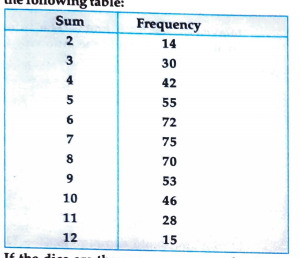 If the dice are thrown once more, what is the probability of getting a sum:
If the dice are thrown once more, what is the probability of getting a sum:
more than 10
View SolutionTwo dice are thrown simultaneously 500 ties. Each time the sum of two numbers appearing on their tops is noted and recorded as given in the following table:
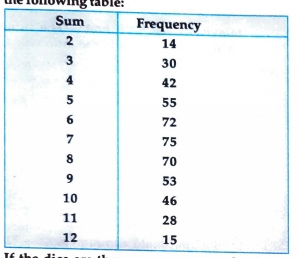 If the dice are thrown once more, what is the probability of getting a sum:
If the dice are thrown once more, what is the probability of getting a sum:
less than or equal to 5?
View SolutionTwo dice are thrown simultaneously 500 ties. Each time the sum of two numbers appearing on their tops is noted and recorded as given in the following table:
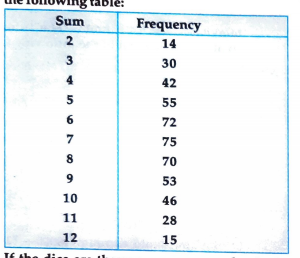 If the dice are thrown once more, what is the probability of getting a sum:
If the dice are thrown once more, what is the probability of getting a sum:
between 8 and 12?
View SolutionOver the apst 200 working days, the number of defective parts produced by a machine is given in the following table:
 Determine the probability that tommorow's output will have
Determine the probability that tommorow's output will have
no defective part.
View SolutionOver the apst 200 working days, the number of defective parts produced by a machine is given in the following table:
 Determine the probability that tommorow's output will have
Determine the probability that tommorow's output will have
at least one defective part.
View SolutionOver the apst 200 working days, the number of defective parts produced by a machine is given in the following table:
 Determine the probability that tommorow's output will have
Determine the probability that tommorow's output will have
not more than 5 defective parts.
View SolutionOver the apst 200 working days, the number of defective parts produced by a machine is given in the following table:
 Determine the probability that tommorow's output will have
Determine the probability that tommorow's output will have
more than 13 defective parts.
View Solution
EXAMPLE questions and complete solutions for chapter PROBABILITY of MODERN PUBLICATION of Class 9